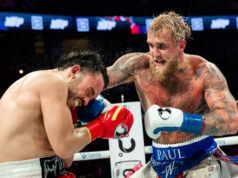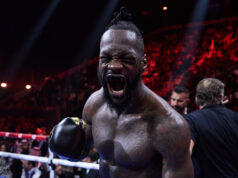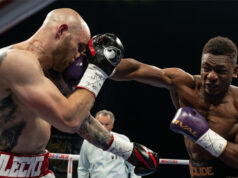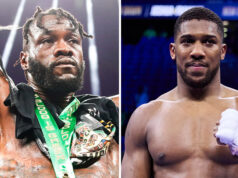Looking Back at the Career Of Under Appreciated Heavyweight Champion Larry Holmes
Larry Holmes, the Easton Assassin, should arguably feature in any hardcore boxing aficionado’s top 5 greatest heavyweights of all time. There can even be a valid case made for an inclusion in the top 3. Instead of this, Holmes’ reign as the world heavyweight boxing champion, an honor historically associated with respect for a man seen to be the best of the best, the prime gladiator of the sport’s flagship division, was somewhat charred with a sense of contempt and resentment.
These are emotions that presented themselves after Holmes somewhat upsetting “dissection” of ring idol Muhammad Ali in 1980. Ali was a media darling and American hero, ironically for making the same stand for his religious beliefs that had previously led to the stripping of his championship 13 years earlier. Public opinion had changed, and with it came the readjustment of attitude towards Ali, who was now admired for protecting his principles rather than avoided for partaking in the practice of “draft dodging” that had so often been negatively raved about by the American media.
Holmes himself was in awe of Ali and acknowledged this during the press conference held after his battering of the former champion. He stated “He was the greatest fighter in the world… He’s one hell of an athlete, one hell of a man. Even trying to win a fourth title is one hell of an achievement. He had a two-year layoff and then tried to fight the baddest heavyweight in the world.” Indeed it is very hard to discredit the claim made by Holmes after this fight. The World Boxing Council Heavyweight champion had in 1978 dethroned champion Ken Norton over 15 great rounds. It was discovered after the fight that Holmes had suffered an injury to his left tricep muscle, an injury that was initially thought to have been sustained in training five days before the fight. This magnifies Holmes achievement immensely. To put things into perspective, it must be remembered that Norton had given Muhammad Ali two of his toughest battles, including breaking Ali’s jaw en route to a points decision win in March 1973. To be able to beat such credible opposition with only one hand in operation deserves serious respect.
Holmes was no stranger to this kind of adversity however. The Easton Assassin possessed arguably the best jab in heavyweight boxing history, honed after an accident involving his right hand that left him only able to train with the left. The jab allowed him to pile on the points against Norton, to humiliate Ali in 1980 without the need for a knockout and beat very capable contenders such as Earnie Shavers, (who is regarded by many as boxing’s hardest hitter pound for pound of all time) twice.
Fights such as these also displayed an iron chin. Holmes was only knocked out once in his 29 year career that began with a points win in 1973 against one Rodell Dupree and ended in a circus like affair against former IBA super heavyweight champion, Eric “Butterbean” Esch, in which Holmes won by unanimous decision, once again employing the famous jab to rack up the points.
Holmes was also no stranger to controversy. During his quest to emulate the record of former undisputed Heavyweight champion Rocky Marciano, Holmes declared that the “Brockton Blockbuster” “is not fit to carry my jockstrap” after losing his coveted 48-0 record against Michael Spinks in 1985. This comment has been attributed as by some as the reasoning behind the public falling out of love with the former champion. One remark, made out of bitterness in reaction to an extremely disputed unanimous decision, seems to have left a permanent smudge on a man who should, in my view, be more widely appreciated. Appreciated for his hard slog on the way up, and for his reign as champion that included 17 defences of the WBC crown and 3 of the IBF, which he adopted in December 1983. However, Holmes was used to playing the villain, whether that role be self-imposed or by way of media storm.
1982 saw the rise of Gerry Cooney, who was being hyped for greatness. The boxing and even the American media in it’s entirety seemed to be intent on taking the focus away from the boxing and focusing it on the wrongful values of old; race. Cooney was an Irish-American blue collar type of fighter. He became immensely popular with the white working class of America and was showcasing knockout power to accompany his popular persona. Wins over Ron Lyle and Jimmy Young, good contenders of the time, plus a knockout of Holmes’s former rival Ken Norton suggested that the New Yorker was ready for the big time.
Following the arrangement of the fight, Cooney was immediately touted as “a great white hope”, someone who was able to make history by becoming the first white heavyweight champion since Rocky Marciano retired in 1956. This darker tone to proceedings increased racial tensions for the fight. Holmes was seen as something of a bad guy and was even dismissed by the President of the United States as a loser in the fight, which was present in order for President Carter to congratulate the “winner” after the fight. The total dismissal by the public of the champion for a reason based on skin color only served to add fuel to Holmes’s determination.
Such an atmosphere would have no doubt reminded him of the appalling rhetoric surrounding both of the Louis-Schmeling encounters decades earlier. As Cooney acknowledged, skills and technical ability should decide the outcome of the fight, not race. Such an admission did nothing to dampen Holmes’ anger and come the night of the fight he put on a great display. The second round saw Cooney hit the deck, perhaps with the realization of the mammoth task at hand. This was not the end by any means though, Cooney did not fold, and pushed the champion hard, trading back and forth through the middle rounds.
The progression of the fight saw Cooney fatigue. In the 9th round he landed a low blow to Holmes’ midsection. This may have indicated an element of desperation. However, after the fight Cooney maintained that the illegal contact was purely accidental. The tenth saw Cooneys’ last stand, using up what was left of his energy in giving Holmes the best he could offer. The two exchanged blows throughout the round, providing exciting viewing. The end saw a mercy stoppage and the end of one of the greatest spectacles of its time, both for the outside actions and in-ring courage. Holmes knocked down the no longer game challenger, who was by now surviving on fighter’s instinct only. This signalled the end for the challenger’s corner, who dived in to stop the fight. The president along with millions of others that night never saw the outcome they had hoped for.
This fight proved that the Easton Assasin had a champion’s will when it came to dealing with adversity. Yet another great quality that should encourage any boxing fan to show him more appreciation. During his career, Holmes racked up a title defense record second only to the great Joe Louis (20); this alone should afford Larry more credibility. His jab, iron chin and stubborn nature (he fought on until 52!) made him a boxing writer’s dream. And that ladies and gents is why Larry Holmes WAS indeed as the title suggests: an underappreciated genius.










